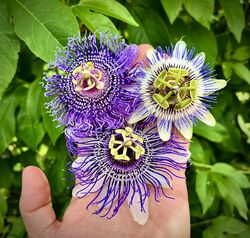 Winter hardy passion fruit is a novelty on the market for edible fruit plants. Thanks to Lubera's own breeding programme, Lubera Edibles is definitely a pioneer in this field.
Winter hardy passion fruit is a novelty on the market for edible fruit plants. Thanks to Lubera's own breeding programme, Lubera Edibles is definitely a pioneer in this field.
The passion fruit range at Lubera Edibles currently consists of two varieties: Cooltropics® Eia Popeia® and Cooltropics® Snowstar®. There is strong demand for both varieties and the Snowstar® variety was awarded the gold medal for Best New Plant at the French Innovert competition in spring 2024. However, we are not resting on our laurels, but want to significantly expand our range of passion fruit varieties in the coming years.
So, we dare to take a quick look into the crystal ball to see what the Passiflora range could look like in five years. Some of this is fairly certain, some still very speculative.
A full-colour range of classic Passiflora incarnata
Let's start with the classic range. Up to this point, we have two colour variants of flower colours: purple and white. In five years, this assortment will very probably include a few more flower colours: pink, purple, salmon, grey, red and blue, for example, are conceivable and some are already being developed. Red and blue will probably be more "reddish" and "bluish" tones, but gardeners are familiar with this. We can then offer a complete range in different colours for the end consumer. That's perfect for sales.
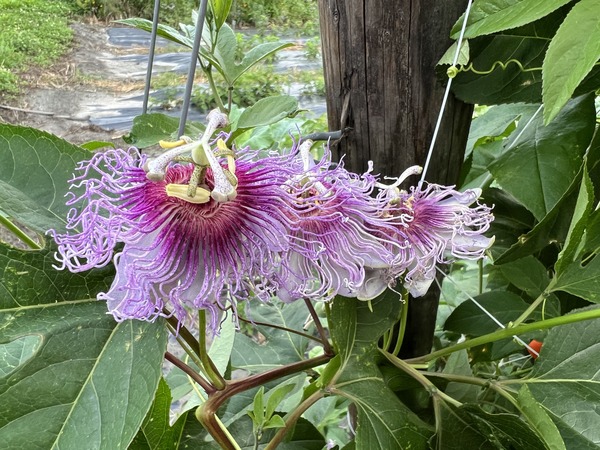
Picture: A new colour variant for the passion flowers in the Cooltropics® range.
A wider range of fruit types for hardy passion fruit
A classic fruit of the hardy Passiflora incarnata weighs 40 g when fully ripe; it is light green with white flesh, soft skin and has a shelf life of three to four days. The plants are self-infertile and the fruit has a tropical, sweet and sour, exotic flavour.
The aim here is also to differentiate more between the fruit types. We are pursuing different directions at the same time: the search for reliably self-fertile plants would be very significant for the hobby market. Not everyone wants to or can grow two plants for cross-pollination. We already have a few self-fertile candidates. Unfortunately, the trait is somewhat complicated, so we are continuing to put our hopeful varieties through their paces in order to be able to offer reliably self-fertile hardy passion fruit.
Fruit size is also an important characteristic. Large-fruited passion fruit in particular would certainly be interesting. Here we have selected the seedlings with the largest fruits. There is already a candidate for fruits with a size of 100 g to 120 g and the working name is ‘Big Boy’. Here the fruits are two to three times the size of previous varieties!

Picture: Fruits of different Passiflora incarnata varieties, with the very large fruit of ‘Big Boy’ on the far right.
As far as the fruit flavour is concerned, it can also be differentiated: varieties with a tart lemon flavour, extremely sweet varieties with a peach flavour or perhaps well-balanced with a strawberry and pineapple flavour. In other words, a real gourmet line. Because we also eat with our eyes, the flesh should also be much more yellow-orange than the previous milky white.
Three years ago, we also made a chance discovery: a "star passion fruit". The fruits of this variety have a beautiful fruit pattern: a red star on a green background. This is guaranteed to be an eye-catcher and certainly worthy of its own variety.
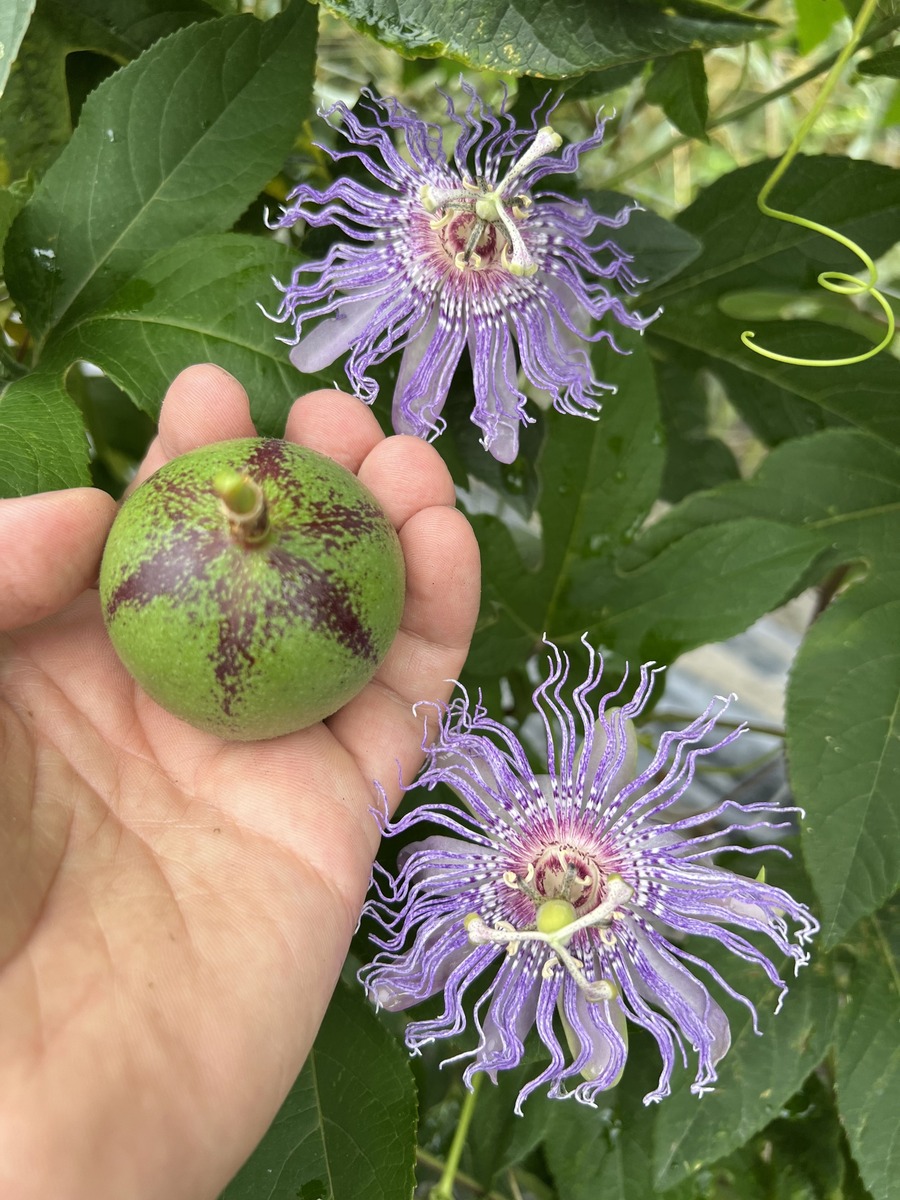
Picture: A future Cooltropics® passion fruit variety with star-shaped fruit markings.
Species hybrid for new directions
Most of our cultivated plants are not pure species but, in some cases, complicated hybrid plants with ancestors of very different species. Well-known examples are wheat, maize and strawberries. However, even modern blackberry varieties sometimes have four to ten different Rubus species from different regions of the world in their ancestors.
If we want to establish hardy passion fruit here in the long term, such hybrid plants would certainly be helpful. They could be used to obtain completely new characteristics.
The first successes: bigger, more beautiful, more durable, better!
One such very complicated hybrid is already in the starting blocks. Like other Cooltropics®, this plant from the Lubera breeding programme has Passiflora incarnata as its base (which gives it its winter hardiness), but other species have also been crossed in: Passiflora tucumanensis from Argentina, which has contributed to very regular flowers, a fantastic fragrance and fast ripening, and Passiflora cincinnata from Venezuela, which has brought in significantly larger flowers, a great citrus flavour and a long fruiting period.
As a result, we have a wonderful plant that is completely hardy, has beautiful, very large, fragrant flowers and exquisitely flavoured fruits that keep for several weeks. This is a whole new league.
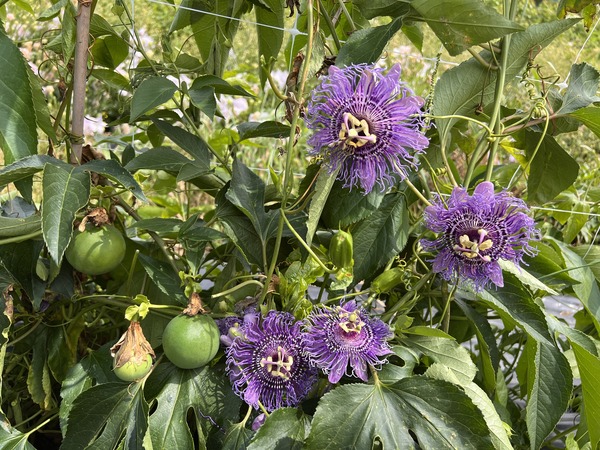
Picture: A new promising hardy passion fruit hybrid variety.
Many possibilities and many problems
In the area of hybrids, we also work with many other plants. The advantage is that the possibilities are almost endless, but the path to a reasonable plant is usually somewhat more difficult and lined with many obstacles. It is therefore difficult to say which of the directions taken will work in the end.
Evergreen hardy passion fruit
The hardy Cooltropics® Passiflora incarnata plants function as perennials. In the winter, the foliage dies back above ground and the plant sprouts again from the root in late spring. This type of winter hardiness has many advantages, but unfortunately also disadvantages. One of the main reasons for complaints is that customers are too impatient and can't wait for the plant to finally sprout. On the one hand, we solve the problem by selecting future Passiflora incarnata varieties for early budding. On the other hand, an evergreen hardy passion fruit could solve this problem. Hybrids with Passiflora caerulea would be particularly suitable. We are working on such solutions here.
Other hybrid plants: ideal for cool summers, or commercial cultivation
Passiflora incarnata loves a very warm summer, but this is not usually the case in many parts of Europe, from the Benelux countries to northern Germany and the United Kingdom. Crossbreeding with Passiflora species from cooler regions would help to acclimatise them to "mucky summers". Examples are hybrids with Passiflora umbilicata or Passiflora tucumanensis, which could lead to passion fruit for cool summer climates.
Even though the hardy passion fruits of Eia Popeia® and Snowstar® taste great, they are very different from typical passion fruit from the supermarket. Crosses with Passiflora edulis could overcome this flaw. Promising intermediate steps have already been taken here too.
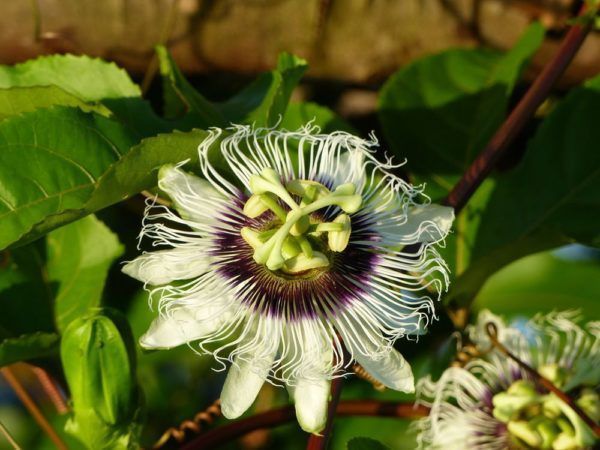
Picture: The flower of Passiflora edulis, the classic purple passion fruit, which is also used for crossing new hybrid varieties.
It is possible that these varieties could soon become interesting for commercial cultivation.
"Minicuyas" for the seed assortment
Lubera Edibles is also slowly venturing into the sale of seeds. The first plants in the seed assortment will be tomatoes. But why not passion fruit too? Passiflora incarnata and hybrids are not very suitable for this. The plants are difficult to germinate and open-pollinated or F1 varieties are very difficult to create. However, there is a great alternative: Minicuyas.
What are Minicuyas? And why are they perfect for the home garden market?
Minicuyas are a group of Passiflora species of the Dysosmia group, which are characterised by the following properties:
• 100% self-fertile (each flower becomes a fruit)
• Very easy to care for (drought-tolerant and uncomplicated)
• Numerous, small, delicious mini passion fruit in different colours
• Easy to propagate from seed
Like tomatoes, these plants are not hardy. However, they don't have to be: they flower and fruit soon after sowing and can easily be grown as annual fruit plants, similar to tomatoes, peppers, physalis and others. They are a terrific and simple addition to balconies and patios.

Picture: The variety of annual Minicuya® plants.
A possible assortment would include three varieties with different fruit colours: green-yellow-red. We are currently testing several candidate varieties for their suitability. The yellow variety is practically ready for the market, the green variety will probably be ready soon and a red variety is currently being tested.
And what else?
There is no shortage of ideas. The question in the end is also this: what is needed? A compact, bushy Passiflora for pots? A plant with flowers that stay open for a very long time? Decorative foliage (red, variegated, etc.)?
All of this is possible and some of it already exists. But is it worth bringing such a variety onto the market? If you as a customer were in charge, what characteristics would you want for the hardy passion fruit of the next generation?
